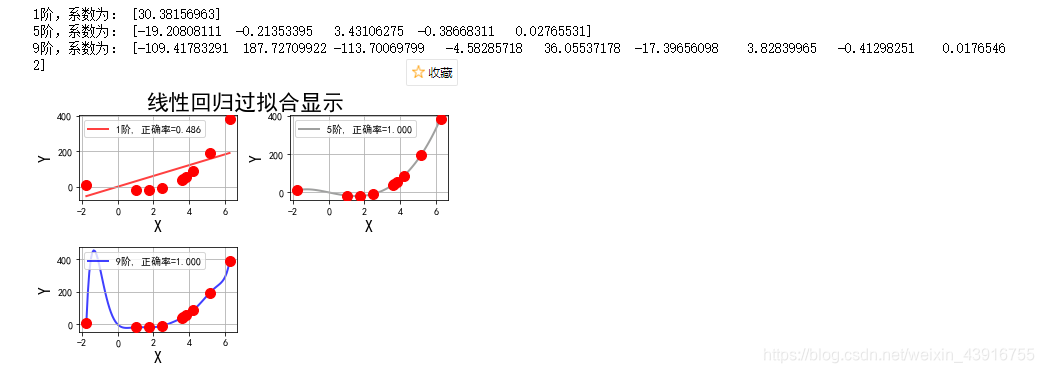import numpy as np
import matplotlib as mpl
import matplotlib.pyplot as plt
import pandas as pd
import warnings
import sklearn
from sklearn.linear_model import LinearRegression,LassoCV,RidgeCV,ElasticNetCV
from sklearn.preprocessing import PolynomialFeatures
from sklearn.pipeline import Pipeline #Pipeline可以将许多算法模型串联起来,比如将特征提取、归一化、分类组织在一起形成一个典型的机器学习问题工作流
from sklearn.linear_model.coordinate_descent import ConvergenceWarning
#设置字符集,防止中文乱码
mpl.rcParams['font.sans-serif']=[u'simHei']
mpl.rcParams['axes.unicode_minus']=False
## 拦截异常
warnings.filterwarnings(action = 'ignore', category=ConvergenceWarning)
#常见模拟数据
np.random.seed(100)
np.set_printoptions(linewidth=1000, suppress=True)#显示方式设置,每行的字符数用于插入换行符,是否使用科学计数法
N=10
x = np.linspace(0, 6, N) + np.random.randn(N)
y = 1.8*x**3 + x**2 - 14*x - 7 + np.random.randn(N)
## 将其设置为矩阵
x.shape = -1, 1
y.shape = -1, 1
## RidgeCV和Ridge的区别是:前者可以进行交叉验证
models = [
Pipeline([
('Poly', PolynomialFeatures(include_bias=False)),
('Linear', LinearRegression(fit_intercept=False))
]),
Pipeline([
('Poly', PolynomialFeatures(include_bias=False)),
# alpha给定的是Ridge算法中,L2正则项的权重值,也就是ppt中的兰姆达
# alphas是给定CV交叉验证过程中,Ridge算法的alpha参数值的取值的范围
('Linear', RidgeCV(alphas=np.logspace(-3,2,50), fit_intercept=False))
]),
Pipeline([
('Poly', PolynomialFeatures(include_bias=False)),
('Linear', LassoCV(alphas=np.logspace(0,1,10), fit_intercept=False))
]),
Pipeline([
('Poly', PolynomialFeatures(include_bias=False)),
# la_ratio:给定EN算法中L1正则项在整个惩罚项中的比例,这里给定的是一个列表;
# 表示的是在CV交叉验证的过程中,EN算法L1正则项的权重比例的可选值的范围
('Linear', ElasticNetCV(alphas=np.logspace(0,1,10), l1_ratio=[.1, .5, .7, .9, .95, 1], fit_intercept=False))
])
]
## 线性模型过拟合图形识别
plt.figure(facecolor='w')
degree = np.arange(1,N,4) # 阶
dm = degree.size
colors = [] # 颜色
for c in np.linspace(16711680, 255, dm):
colors.append('#%06x' % int(c))
model = models[0]
for i,d in enumerate(degree):
plt.subplot(int(np.ceil(dm/2.0)),2,i+1)
plt.plot(x, y, 'ro', ms=10, zorder=N)
# 设置阶数
model.set_params(Poly__degree=d)
# 模型训练
model.fit(x, y.ravel())
lin = model.get_params('Linear')['Linear']
output = u'%d阶,系数为:' % (d)
# 判断lin对象中是否有对应的属性
if hasattr(lin, 'alpha_'):
idx = output.find(u'系数')
output = output[:idx] + (u'alpha=%.6f, ' % lin.alpha_) + output[idx:]
if hasattr(lin, 'l1_ratio_'):
idx = output.find(u'系数')
output = output[:idx] + (u'l1_ratio=%.6f, ' % lin.l1_ratio_) + output[idx:]
print (output, lin.coef_.ravel())
x_hat = np.linspace(x.min(), x.max(), num=100) ## 产生模拟数据
x_hat.shape = -1,1
y_hat = model.predict(x_hat)
s = model.score(x, y)
z = N - 1 if (d == 2) else 0
label = u'%d阶, 正确率=%.3f' % (d,s)
plt.plot(x_hat, y_hat, color=colors[i], lw=2, alpha=0.75, label=label, zorder=z)
plt.legend(loc = 'upper left')
plt.grid(True)
plt.xlabel('X', fontsize=16)
plt.ylabel('Y', fontsize=16)
plt.tight_layout(1, rect=(0,0,1,0.95))
plt.suptitle(u'线性回归过拟合显示', fontsize=22)
plt.show()

线性回归、Lasso回归、Ridge回归、ElasticNet比较
plt.figure(facecolor='w')
degree = np.arange(1,N, 2) # 阶, 多项式扩展允许给定的阶数
dm = degree.size
colors = [] # 颜色
for c in np.linspace(16711680, 255, dm):
colors.append('#%06x' % int(c))
titles = [u'线性回归', u'Ridge回归', u'Lasso回归', u'ElasticNet']
for t in range(4):
model = models[t]#选择了模型--具体的pipeline(线性、Lasso、Ridge、EN)
plt.subplot(2,2,t+1) # 选择具体的子图
plt.plot(x, y, 'ro', ms=10, zorder=N) # 在子图中画原始数据点; zorder:图像显示在第几层
# 遍历不同的多项式的阶,看不同阶的情况下,模型的效果
for i,d in enumerate(degree):
# 设置阶数(多项式)
model.set_params(Poly__degree=d)
# 模型训练
model.fit(x, y.ravel())
# 获取得到具体的算法模型
# model.get_params()方法返回的其实是一个dict对象,后面的Linear其实是dict对应的key
# 也是我们在定义Pipeline的时候给定的一个名称值
lin = model.get_params()['Linear']
# 打印数据
output = u'%s:%d阶,系数为:' % (titles[t],d)
# 判断lin对象中是否有对应的属性
if hasattr(lin, 'alpha_'): # 判断lin这个模型中是否有alpha_这个属性
idx = output.find(u'系数')
output = output[:idx] + (u'alpha=%.6f, ' % lin.alpha_) + output[idx:]
if hasattr(lin, 'l1_ratio_'): # 判断lin这个模型中是否有l1_ratio_这个属性
idx = output.find(u'系数')
output = output[:idx] + (u'l1_ratio=%.6f, ' % lin.l1_ratio_) + output[idx:]
# line.coef_:获取线性模型的参数列表,也就是我们ppt中的theta值,ravel()将结果转换为1维数据
print (output, lin.coef_.ravel())
# 产生模拟数据
x_hat = np.linspace(x.min(), x.max(), num=100) ## 产生模拟数据
x_hat.shape = -1,1
# 数据预测
y_hat = model.predict(x_hat)
# 计算准确率
s = model.score(x, y)
# 当d等于5的时候,设置为N-1层,其它设置0层;将d=5的这条线凸显出来
z = N + 1 if (d == 5) else 0
label = u'%d阶, 正确率=%.3f' % (d,s)
plt.plot(x_hat, y_hat, color=colors[i], lw=2, alpha=0.75, label=label, zorder=z)
plt.legend(loc = 'upper left')
plt.grid(True)
plt.title(titles[t])
plt.xlabel('X', fontsize=16)
plt.ylabel('Y', fontsize=16)
plt.tight_layout(1, rect=(0,0,1,0.95))
plt.suptitle(u'各种不同线性回归过拟合显示', fontsize=22)
plt.show()

可以看出在不进行正则化的情况下, 9阶比较:




加上正则后参数明显降下来了





















 1544
1544











 被折叠的 条评论
为什么被折叠?
被折叠的 条评论
为什么被折叠?








